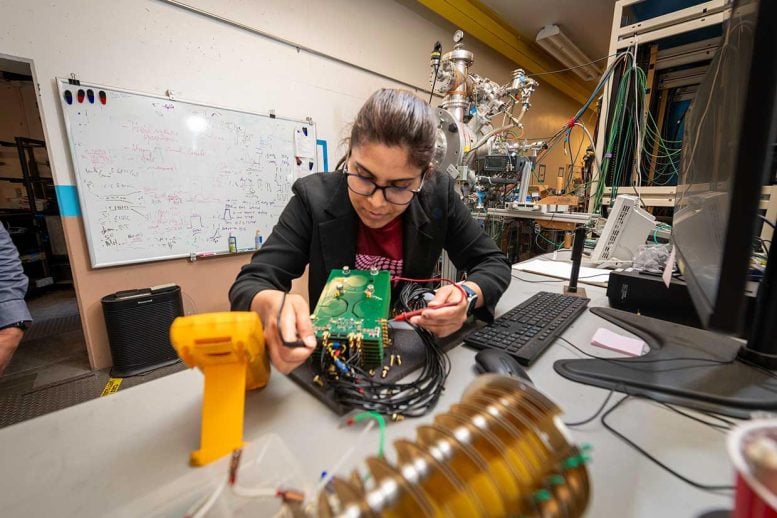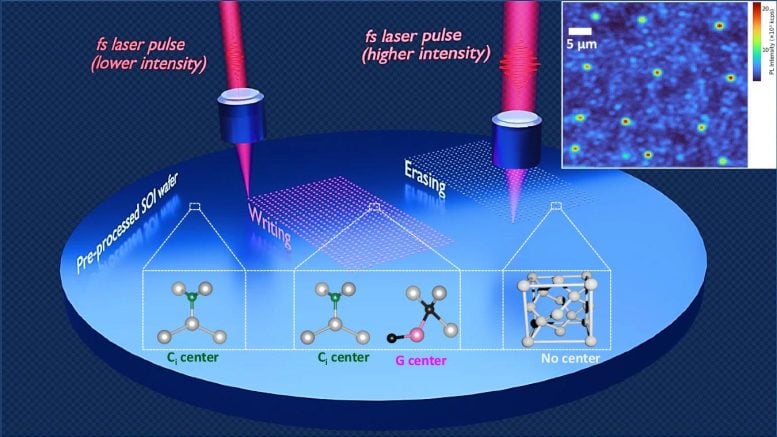
Researchers at Lawrence Berkeley National Laboratory have developed a method using a femtosecond laser and hydrogen doping to create and control qubits in silicon, potentially revolutionizing quantum computing by enabling precise qubit placement and connectivity for scalable quantum networks and the quantum internet. Credit: SciTechDaily.com
Berkeley Lab’s new technique uses femtosecond lasers and hydrogen to precisely create qubits in silicon, advancing prospects for scalable 
Kaushalya Jhuria in the lab testing the electronics that are part of the experimental setup used for making qubits in silicon. Credit: Thor Swift/Berkeley Lab
Quantum Computing’s Potential and Challenges
Quantum computers have the potential to solve complex problems in human health, drug discovery, and
Breakthroughs in Qubit Creation and Control
But now, getting qubits to connect may soon be possible. A research team led by Lawrence Berkeley National Laboratory (Berkeley Lab) says that they are the first to use a femtosecond laser to create and “annihilate” qubits on demand, and with precision, by doping silicon with hydrogen.
The advance could enable quantum computers that use programmable optical qubits or “spin-
An artistic depiction of a new method to create high-quality color-centers (qubits) in silicon at specific locations using ultrafast laser pulses (femtosecond, or one quadrillionth of a second). The inset at the top-right shows an experimentally observed optical signal (photoluminescence) from the qubits, with their structures displayed at the bottom. Credit: Kaushalya Jhuria/Berkeley Lab
Potential and Future Directions
The researchers learned that processing silicon with a low femtosecond laser intensity in the presence of hydrogen helped to create the Ci color centers. Further experiments showed that increasing the laser intensity can increase the mobility of hydrogen, which passivates undesirable color centers without damaging the silicon lattice, Schenkel explained.
A theoretical analysis performed by Liang Tan, staff scientist in Berkeley Lab’s Molecular Foundry, shows that the brightness of the Ci color center is boosted by several orders of magnitude in the presence of hydrogen, confirming their observations from laboratory experiments.
“The femtosecond laser pulses can kick out hydrogen atoms or bring them back, allowing the programmable formation of desired optical qubits in precise locations,” Jhuria said.
The team plans to use the technique to integrate optical qubits in quantum devices such as reflective cavities and waveguides, and to discover new spin photon qubit candidates with properties optimized for selected applications.
“Now that we can reliably make color centers, we want to get different qubits to talk to each other – which is an embodiment of quantum entanglement – and see which ones perform the best. This is just the beginning,” said Jhuria.
“The ability to form qubits at programmable locations in a material like silicon that is available at scale is an exciting step towards practical quantum networking and computing,” said Cameron Geddes, Director of the ATAP Division.
Reference: “Programmable quantum emitter formation in silicon” by K. Jhuria, V. Ivanov, D. Polley, Y. Zhiyenbayev, W. Liu, A. Persaud, W. Redjem, W. Qarony, P. Parajuli, Q. Ji, A. J. Gonsalves, J. Bokor, L. Z. Tan, B. Kanté and T. Schenkel, 27 May 2024, Nature Communications.DOI: 10.1038/s41467-024-48714-2
Source: SciTechDaily

